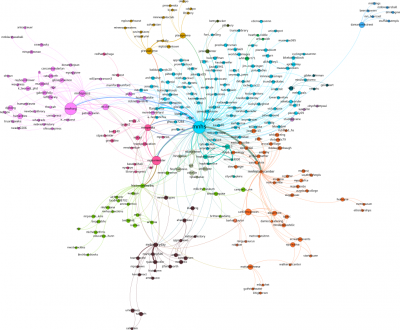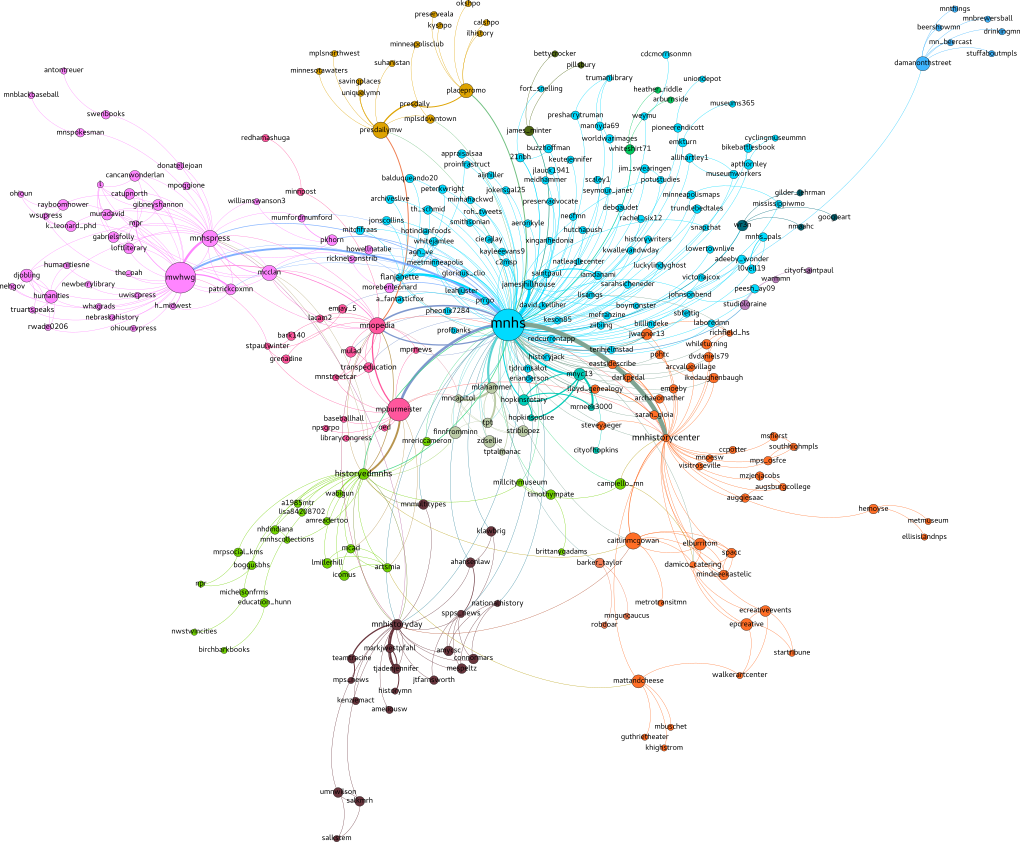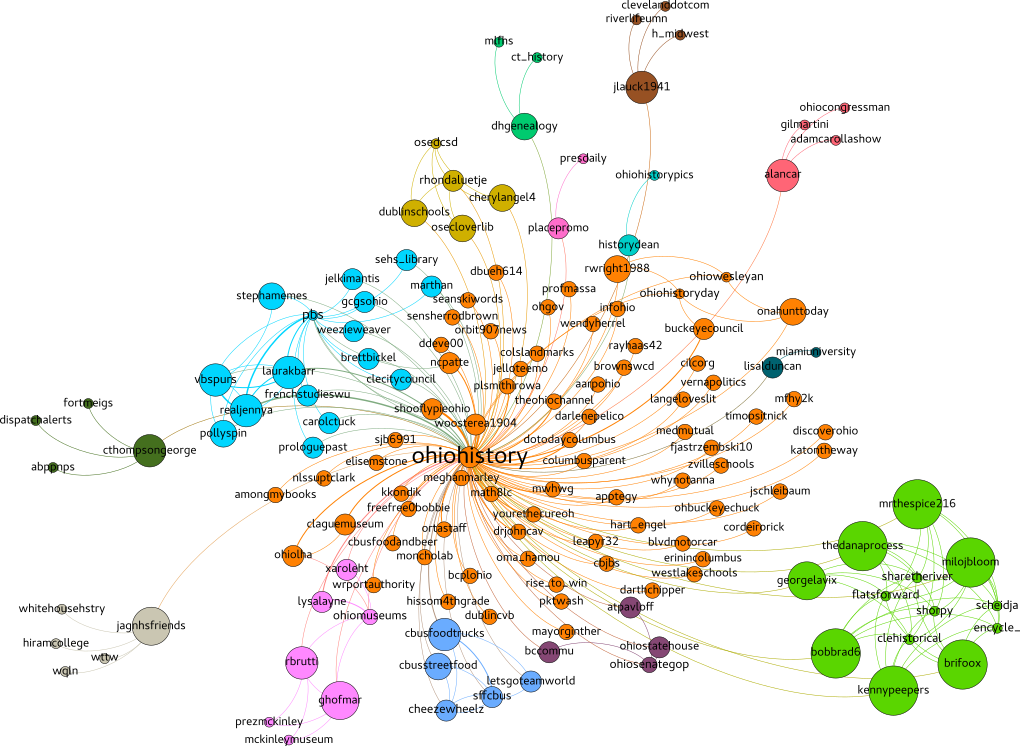State History Organizations on Twitter: Comparing Minnesota and Ohio

Twitter has become a popular platform for sharing history since its launch in 2006. Although it is only used by about 23% of online adults, more often in urban than rural areas, Twitter is a useful resource for connecting with segments of the online public. The Minnesota Historical Society and the Ohio History Connection were among the first big history institutions in the Midwest to embrace the platform. A casual comparison of their current Twitter profiles illustrates some best practices while revealing how these organizations differ in using Twitter to advance their missions.
Minnesota Historical Society (@mnhs)
The mission of the Minnesota Historical Society is “Using the Power of History to Transform Lives.” This is an ambitious mission, but the society’s Twitter use appears to work towards it.
The society’s main Twitter profile, @mnhs, was created in August 2008 and now has 14.9 thousand followers. Its popularity attests to its longevity and its content. While the Minnesota Historical Society uses Twitter to promote its own programs and collections, it also connects these promotions with interesting or informative content such as trivia and historical images, as in the tweet below:
A class at Richfield HS, 1955. Don't forget to visit Suburbia and get 2-for-1 tickets w/ the code word "Richfield!" pic.twitter.com/Pn1AJg5lMT
— Minnesota Historical Society (@mnhs) February 6, 2016
In addition to self-promotion, the Minnesota Historical Society frequently retweets or promotes related material from other history and news organizations in Minnesota and even beyond, such as the following item about the New York Times’ Black History archive first tweeted by PBS’s Frontline:
Check out @nytimes' "Unpublished Black History" archive https://t.co/Jgo4n1rRIa pic.twitter.com/HHBeuHajcH
— FRONTLINE (@frontlinepbs) February 5, 2016
Minnesota Historical Society’s willingness to share content from beyond its institutional walls makes its Twitter profile a general hub of discussion for history and its present relevancy in Minnesota. Despite the breadth of its content, however, the society keeps the number of tweets on this profile to an average of 3.1 a day (according to Twitonomy), a steady but manageable volume.
In addition to its primary profile, many of the Minnesota Historical Society’s divisions have their own Twitter accounts and followings. The Minnesota History Center, for instance, promotes its events and programs at @mnhistorycenter. Another profile @MNopedia, tweets facts and historic images from the society’s online encyclopedia. The society press shares news on its publications at @mnhspress. The institution facilitates programming for teachers and students at @historyedmnhs and @mnhistoryday. Many MNHS historic sites also have a separate profile.
How do other Twitter users engage with the Minnesota Historical Society and its many profiles? The graph below shows the network of tweets that mentioned or replied to one of the Minnesota Historical Society’s Twitter handles during the week from January 28 to February 5, 2016. Activity varies from week to week, so this sample is too small to make scientific conclusions. Still, it provides a quick impression of how Twitter users discuss the society. Lines connect accounts to the other profiles they mentioned (or to the accounts that mentioned them). The more mentions an account made of other users in this network, the larger the circle representing it appears. Accounts are colored according to their modularity, which helps distinguish different communities of users.

The Minnesota Historical Society’s mention network is sizeable, but although several different conversation groups can be distinguished, they are mostly well connected. The large size of the @mnhs profile in this graph indicates that it is not only being mentioned, but also mentioning, retweeting, and replying to other users — a healthy sign of two way conversation between the institution and its constituents.
Although separate communities are evident around @mnhs (light blue) and @mnhistorycenter (orange, lower right), the thick line of mentions between them suggest that content is effectively cross-promoted between these accounts. Several Twitter users appear to have mentioned both. Other networks are visible around preservation issues (gold, top), history education and collections (bright green, lower left), and history day (brown, bottom left), indicating how the Minnesota Historical Society’s different accounts serve different interests.
The purplish-pink cluster on the upper left side of the graph is clustered around @mwhwg (The Midwest History Association) and @mnhspress. It shared fewer mentions with users in the central network, suggesting they were mostly having their own conversation. That makes sense as this group draws from a wider geography and may be a bit more oriented around scholarship, but it might represent an opportunity for MNHS to bring these users into closer dialog with the rest of the network.
Ultimately, even if the Minnesota Historical Society’s mission to “transform lives” is a greater task than can be accomplished on Twitter alone, the large network of Twitter users who actively discuss the society suggests that its resources and programs are meaningful to many people.
Ohio History Connection (@ohiohistory)
The Ohio History Connection (formerly the Ohio Historical Society) has the mission to “Spark discovery of Ohio’s stories. Embrace the present, share the past and transform the future.” The organization’s Twitter profile serves this mission, demonstrating that OHC has embraced new media to share history.
The primary Twitter presence of the Ohio History Connection is @ohiohistory, an account launched in March 2008 that now has 12.9 thousand followers. The account tweets around 2.3 a day on average, according to Twitonomy.
Recent tweets by the Ohio History Connection have included promotions of the institution’s events and publications, as well as many historic images and on this day (hashtag #OTD) tweets. Most include images to draw visual interest. Some posts are posed as questions, drawing engagement from at least a few followers.
Our Museum in a Box kits feature objects students can touch. What object would you choose? https://t.co/PO2KlXcKUc pic.twitter.com/MD4TKtDnC0
— Ohio History Connection (@OhioHistory) January 26, 2016
Unlike the Minnesota Historical Society, the Ohio History Connection appears to only rarely retweet or share material from other institutions and Twitter accounts. This could be an opportunity for OHC to better “embrace the present” by sharing and contextualizing current material from outside the institution itself.
Also unlike the Minnesota Historical Society, the Ohio History Connection appears to consolidate most of its Twitter use under the single @ohiohistory account. An exception is the @ohiohistoryday profile, which shared announcements for the organization’s National History Day program. The use of fewer profiles helps keep the organization’s messaging consistent and its community of followers tightknit, but it may also reduce OHC’s ability to specifically target communities of different interests.
The graph below shows the network of tweets that mentioned or replied to one of the Ohio History Connection’s Twitter handles during the week from January 28 to February 5, 2016.

The mentions network for the Ohio History Connection immediately appears a bit smaller and more unified than that of MNHS, which reflects OHC’s use of fewer profiles and their slightly smaller follower count.
It seems notable that the circle representing @ohiohistory itself is not particularly large relative to others, indicating that @ohiohistory did not mention other accounts this week to the extent that @mnhs did. This reflects the fact that the Ohio History Connection doesn’t need to share content between several profiles under its control, but it also suggests that OHC could engage its followers in more two-way conversation.
The bright green community on the lower right side of the chart includes several users with very large well connected circles, suggesting that they were all mentioning each other in a conversation. As it happens, they were discussing historical photos tweeted by @ShareTheRiver. The fact that many of their tweets mentioned @ohiohistory is a good sign of its reputation with these users, but it doesn’t appear that the Ohio History Connection took part in the conversation. Maybe photo discussions are one way in which @ohiohistory could more directly engage Twitter users or spark similar conversations of its own.
Can you tell us where this 1905 #CuyahogaRiver image that @scheidja shared with us was taken from? #ThisWasCLE #TBT pic.twitter.com/kGZcttxMED
— Share The River (@ShareTheRiver) January 28, 2016
Conclusion
Based on this comparison — which, again, was only impressionistic — the Minnesota Historical Society and the Ohio History Connection both appear to use Twitter very effectively, attracting large followings and becoming the subject of hundreds of tweets a week by other users. The main differences appear to be Minnesota’s greater tendency to share outside content and its use of many separate profiles for different parts of the organization, compared to Ohio’s more self-contained single major profile.
Which state’s approach do you like better? How might either organization improve? Is it feasible for smaller history institutions with fewer resources to utilize the example set by Minnesota or Ohio to build their Twitter presence? Please share your thoughts in the comments.